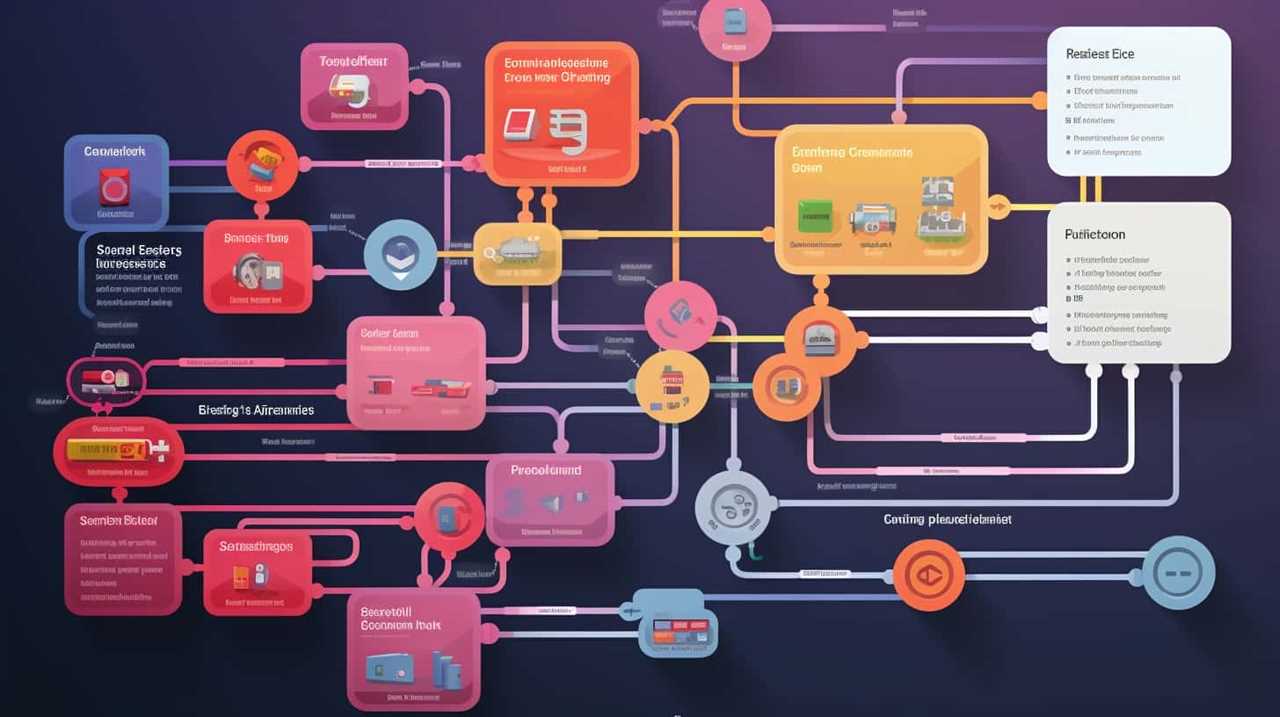Did you know that over 90% of online explorations start with a search engine? We have the power to enhance the caliber of content and boost its visibility by employing effective SEO techniques, all within our grasp.
In this article, we’ll show you how to optimize your website using keyword research, meta tags, engaging content, and more. By implementing these strategies, you’ll not only attract more visitors but also provide them with a liberating user experience.
Let’s dive in and take your content to new heights!
Key Takeaways
- Thorough keyword research is crucial for optimizing content quality and improving SEO.
- Incorporating SEO strategies enhances visibility, reaches a wider audience, and delivers valuable information.
- Enhancing on-page SEO elements creates a user-friendly and search engine-friendly website.
- Consistently creating high-quality and engaging content attracts and retains users.
Understanding the Importance of SEO for Content Quality
We believe that SEO plays a crucial role in ensuring high-quality content.

Effective SEO techniques for improving website visibility are essential for attracting organic traffic and increasing the visibility of your website in search engine results pages (SERPs).
When your website ranks higher in SERPs, it has a greater chance of being discovered by users searching for relevant keywords. This increased visibility not only drives more organic traffic to your website but also enhances the overall user experience.
By incorporating SEO best practices, such as optimizing your website’s structure, using relevant keywords, and creating high-quality, user-focused content, you can significantly impact your organic search rankings.
As a result, your website will gain more visibility, reach a wider audience, and ultimately deliver valuable information to those seeking liberation.

Conducting Thorough Keyword Research
How can we effectively conduct thorough keyword research to optimize our content quality and improve SEO?
Conducting keyword research is a crucial step in creating high-quality content that attracts organic traffic. To begin, start by identifying long tail keywords that are specific and relevant to your content. Long tail keywords have lower search volume but are more specific, making it easier for your content to rank higher in search engine results.
Next, perform competitive analysis to understand what keywords your competitors are targeting. This will help you identify any gaps or opportunities in the market. By incorporating these keywords strategically in your content, you can increase your chances of ranking higher and attracting relevant traffic.
Now, let’s move on to the next section, where we’ll discuss optimizing meta tags and descriptions to further enhance our content’s visibility and click-through rates.

Optimizing Meta Tags and Descriptions
To optimize the visibility and click-through rates of our content, we can enhance the meta tags and descriptions using effective SEO techniques. Meta tags and descriptions are crucial elements that provide search engines and users with a concise summary of our webpage’s content. By incorporating relevant keywords and compelling descriptions, we can improve our webpage visibility and increase click-through rates.
When optimizing meta tags, it’s important to include keywords that accurately reflect the content of the page. This helps search engines understand the context of our webpage and rank it accordingly. Additionally, we should write compelling descriptions that entice users to click on our link in the search results.
To achieve this, we can focus on creating concise and engaging meta tags and descriptions that highlight the value our content offers. By optimizing these elements, we can attract more organic traffic and improve the overall performance of our website.
Enhancing On-Page SEO Elements
One key aspect of enhancing content quality with effective SEO techniques is improving the on-page SEO elements. By optimizing these elements, we can make our website more user-friendly and search engine-friendly. Here are three important on-page SEO elements to focus on:

- Improving website speed: A slow-loading website can frustrate users and negatively impact their experience. By optimizing website speed, we can ensure that visitors can access our content quickly and easily.
- Optimizing images: Images play a crucial role in engaging users, but they can also slow down a website if not optimized properly. By compressing images, choosing the right file formats, and adding alt tags, we can improve page load times and enhance the user experience.
- Utilizing proper heading tags: Heading tags, such as H1, H2, and H3, help search engines understand the structure of our content. By using these tags correctly and incorporating relevant keywords, we can improve the visibility of our content in search engine results.
Enhancing these on-page SEO elements will lay a solid foundation for creating high-quality and engaging content that won’t only attract users but also rank well in search engine results.
Creating High-Quality and Engaging Content
As we continue to enhance content quality with effective SEO techniques, it’s important to consistently create high-quality and engaging content that resonates with our audience.
Content optimization plays a crucial role in attracting and retaining users, as it ensures that our content is easily discoverable by search engines. By incorporating relevant keywords, we can improve our organic rankings and increase visibility.
However, it’s equally important to prioritize user experience and engagement. Our audience desires liberation from generic, uninteresting content. To achieve this, we must focus on delivering valuable and informative content that addresses their needs and interests.

Incorporating multimedia elements, such as images, videos, and interactive features, can further enhance engagement and make our content more appealing.
Implementing Proper Internal Linking Strategies
When it comes to improving our website’s rankings and enhancing user experience, implementing proper internal linking strategies is key.
By strategically linking relevant pages within our own website, we can’t only boost our site’s visibility on search engine results, but also make it easier for users to navigate through our content.
This means that not only are we increasing our chances of being discovered by search engines, but we’re also maximizing the user’s ability to find the information they need quickly and easily.

Linking for Improved Rankings
To enhance the rankings of our content, we can implement proper internal linking strategies by strategically linking relevant keywords within our website. This not only helps search engines understand the context of our content, but also improves the user experience by providing easy navigation and access to related information.
Here are three key ways internal linking can boost our rankings:
- Establishing authority: By linking to our own high-quality content, we show search engines that we’ve valuable and relevant information to offer. This can help improve our website’s authority and credibility in the eyes of search engines.
- Distributing link juice: Internal links pass on link equity or ‘link juice’ to other pages on our website. By strategically linking from high-authority pages to those that need a boost, we can improve the rankings of the latter.
- Optimizing anchor text: Using relevant keywords as anchor text in our internal links can help search engines understand the topic and relevance of the linked page. This can improve the rankings of both the linked page and the target page.
Maximizing User Navigation
To maximize user navigation and improve content quality, we implement proper internal linking strategies. Internal links play a crucial role in guiding users through your website and enhancing their overall experience. By strategically placing relevant internal links within your content, you can help users find additional information that’s related to their interests or queries. This not only keeps them engaged but also encourages them to spend more time on your site, reducing bounce rates and improving site speed.
Additionally, optimizing internal links can also benefit your SEO efforts. By using descriptive anchor text and linking to relevant pages, you can signal to search engines the importance and relevance of these pages. This can help improve your site’s visibility in search results, especially when optimizing for voice search.

Now, let’s delve into the next section and explore the importance of utilizing structured data markup in enhancing content quality and SEO performance.
Utilizing Structured Data Markup
We have found that implementing a well-structured data markup significantly enhances the quality of content for SEO purposes. By utilizing structured data markup, we can improve search visibility and increase organic traffic to our website.
Here are three ways in which structured data markup can benefit your content:
- Rich Snippets: Structured data markup allows search engines to understand your content better and display relevant information in search results. This can increase click-through rates and drive more organic traffic to your site.
- Improved User Experience: Structured data markup helps organize and present information in a more user-friendly way, making it easier for visitors to navigate and find what they’re looking for. This enhances the overall user experience and encourages them to stay longer on your site.
- Enhanced Mobile Optimization: With the rise of mobile usage, structured data markup plays a crucial role in optimizing your content for mobile devices. It helps search engines understand and display your content correctly on smaller screens, improving user experience and search visibility.
Incorporating structured data markup into your content strategy can have a significant impact on your SEO efforts, ultimately leading to higher search visibility and increased organic traffic.

Optimizing for Mobile and User Experience
Implementing structured data markup enhances the quality of content for SEO purposes. Optimizing for mobile and user experience is essential for further improving content quality.
In today’s fast-paced digital world, users expect websites to load quickly and provide a seamless browsing experience on any device. To meet these expectations, it’s crucial to optimize your website for mobile devices. This includes using responsive design, optimizing images and videos, and improving loading speed.
Additionally, with the rise of voice search, it’s important to optimize your content for voice queries. Consider using conversational language, answering common questions, and structuring your content in a way that’s easily digestible for voice search devices.
Monitoring and Analyzing SEO Performance
When it comes to monitoring and analyzing SEO performance, there are a few essential metrics that we need to keep an eye on.

Tracking keyword rankings allows us to see how our content is performing in search engine results.
Analyzing traffic patterns helps us understand how users are finding and interacting with our website.
Essential SEO Metrics
To effectively monitor and analyze our SEO performance, it’s crucial to track and measure essential SEO metrics. These metrics provide valuable insights into the effectiveness of our optimization efforts and help us gauge the success of our SEO strategy.
Here are three key SEO metrics that we should pay close attention to:

- Organic Traffic: This metric measures the number of visitors who arrive at our website through organic search results. By analyzing organic traffic, we can determine the impact of our SEO efforts on attracting relevant and valuable traffic.
- Conversion Rate: Conversion rate measures the percentage of website visitors who complete a desired action, such as making a purchase or filling out a lead form. Monitoring conversion rate helps us understand the effectiveness of our website in converting visitors into customers.
- Keyword Rankings: This metric tracks the position of our website in search engine results for targeted keywords. By monitoring keyword rankings, we can assess the visibility and competitiveness of our website in search engine rankings.
Tracking Keyword Rankings
Continuing from our previous discussion on essential SEO metrics, let’s now delve into the importance of tracking keyword rankings for monitoring and analyzing our SEO performance.
Tracking keyword rankings allows us to see how well our website is performing in search engine results pages (SERPs). By monitoring our rankings, we can identify which keywords are driving the most traffic to our site and make informed decisions on how to optimize our content for better visibility.
Additionally, tracking keyword rankings helps us understand our competitors’ strategies through competitor analysis. We can identify the keywords they’re targeting and adjust our own strategy accordingly. Long tail keywords are especially valuable in this regard, as they often have lower competition and can drive highly targeted traffic to our site.
Analyzing Traffic Patterns
One important aspect of monitoring and analyzing SEO performance is by analyzing traffic patterns. By doing so, we can gain valuable insights into the effectiveness of our SEO strategies and identify areas for improvement.

Here are three key reasons why analyzing traffic patterns is crucial:
- Analyzing Conversion Rates: By examining the traffic patterns on our website, we can determine how many visitors are taking the desired action, such as making a purchase or subscribing to a newsletter. This helps us evaluate the success of our SEO efforts in driving conversions.
- Evaluating User Engagement: Traffic patterns can reveal how users are engaging with our content. By analyzing metrics like bounce rate, time spent on page, and pages per visit, we can understand how well our website is capturing and holding the attention of visitors.
- Identifying High-Performing Pages: By analyzing traffic patterns, we can identify which pages are attracting the most traffic and driving the highest conversions. This allows us to optimize these pages further and replicate their success across the website.
Analyzing traffic patterns is an essential part of optimizing our SEO strategies and improving the overall performance of our website.
Frequently Asked Questions
How Can I Write High-Quality and Engaging Content That Is Optimized for Seo?
We know how to write high-quality and engaging content optimized for SEO. By balancing content creation and user engagement, we strike the right balance for SEO success. Let us show you how.
What Are Some Effective Strategies for Implementing Proper Internal Linking?
What if we told you there’s a way to boost your SEO and improve user experience at the same time? Effective internal linking strategies not only enhance content quality but also offer numerous benefits.

How Can I Optimize My Website for Mobile and Improve the User Experience?
We can optimize our website for mobile and improve the user experience by implementing mobile optimization techniques and user experience improvement strategies. These techniques and strategies will enhance our website’s performance and make it more user-friendly.
What Are Some Key Metrics and Tools to Monitor and Analyze SEO Performance?
Monitoring and analyzing SEO performance requires tracking key metrics and utilizing tools. We can measure keyword ranking and website traffic to gauge success. It’s like having a compass and binoculars, guiding our journey towards liberation.
How Can I Effectively Utilize Structured Data Markup to Enhance My Website’s Visibility in Search Results?
To enhance website visibility in search results, we can effectively utilize schema markup. It helps search engines understand our content better, leading to higher rankings. By implementing structured data markup, we improve our website’s chances of appearing prominently in search engine results.
Conclusion
In conclusion, by implementing effective SEO techniques, we can catapult our content quality to new heights.

It’s like unleashing a pack of hungry wolves on the search engine landscape, devouring the competition and emerging as the alpha predator.
Through thorough keyword research, optimizing meta tags, creating engaging content, and optimizing for mobile and user experience, we can ensure our content reigns supreme.
So, let’s strap on our SEO armor and conquer the digital realm with our keyword-rich, user-focused content!







